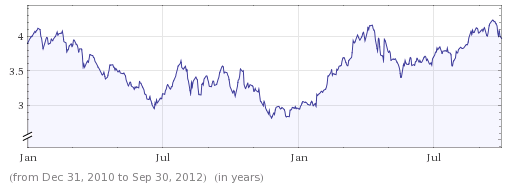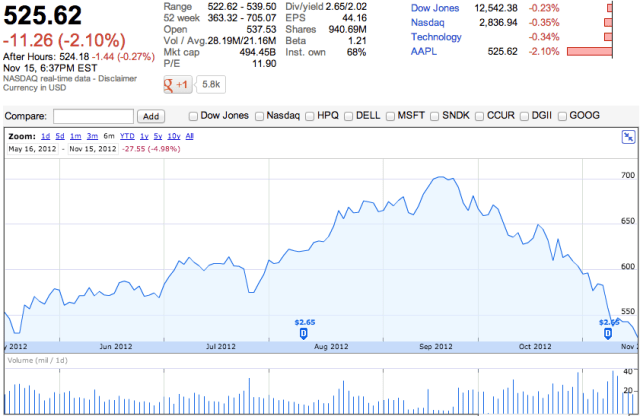The good times can’t last forever. Eventually the music dies off, the balloons pop and everyone goes home.
Without sounding the hyperbole alarm, let’s look at the facts. Apple’s stock price has declined steadily since September 19, two days before the iPhone 5 was released. Shares are off 25 percent since September. The stock price closed at a six-month low today. The price is still up 30 percent on the year but far from its 74 percent increase a few months back.
Analysts are still bullish on Apple. Per Yahoo Finance, more analysts list AAPL with a buy recommendation this month as they did last month or even three months ago. But the stock’s price is expensive. In order for a stock price to increase, it requires new investors, something that Apple is seemingly losing.
CNBC reminds us that mutual and hedge funds make up a sizable chunk of Apple’s stockholders. And now, for reasons not noted, they’re selling off their shares. Without the backing of these funds, the stock price will naturally decline.
Yet, when digging a little bit more, CNBC is a bit too alarming. When it comes to volume, Apple has been very stable for the past three years. If the stock price is to decline, it will happen slowly over time. Apple is not experiencing a self-defeating prophecy, in the economic sense.
Moreover, the anticipation for the iPhone 5 was important. As always, markets tend to anticipate product releases and reflect that in the stock price. Between July 2 and September 19, the stock price increased 18 percent.
In addition to that, the ratio market capitalization over revenue has actually increased for Q3 and Q4 2012, ending September 30, 2012. It’s too early to tell whether it will decrease in Q1 2013, as Apple expects to reach its biggest revenue in company history, so the stock price could fluctuate in both directions. Nevertheless, on September 30, AAPL was trading at four times Apple’s yearly revenue. It is impressive for an established company, and even more so for a giant such as Apple.
Market cap/yearly revenue

Finally, Apple has been ramping up its products for the holidays with multiple important releases in September and October — the iPhone 5, the iPad mini, new iPods, the new iPad, iMac, MacBook Pro, and the Mac mini. Releasing this many products in such a short timeframe is an unprecedented choice for Apple, and it will certainly boost Q1 2013 revenue. Investors are waiting for those earnings after two quarters below or right on expectations. Mutual and hedge funds could also make a comeback.
Apple is still the same company today it was three months ago. It still has the same balance sheet and blockbuster products. Don’t think for a second that something like the competing Nexus 4 or Mapgate can move markets like this. The iPad mini will likely be this year’s hottest holiday gift, and the iPhone 5 will likely outsell every other smartphone on earth. None of that has changed.
But it’s hard to deny that something has changed at Apple.
There’s a different feeling around the company. Once a scrappy underdog fighting the establishment, the company’s popularity (and stock price) shot up with each newly released product. Then, nearly overnight, Apple went from being the little guy to the one to beat. It went from David to Goliath. And with that change, a lot of the hopeful optimism slowly faded.
Apple is slowly transforming from being a superstar stock to one that pays a fair dividend at a modest rate in order to make existing investors happy. A classic blue chip. The next IBM or Home Depot. For just the second time since 1995, Apple paid a quarterly dividend last week.
A stock price is a silly metric to weigh a company’s health. It might just say something about Apple’s identity. While Apple’s stock price might decline for the foresable future, the company itself will continue to pump out best-selling products and services.

Romain Dillet contributed reporting.
